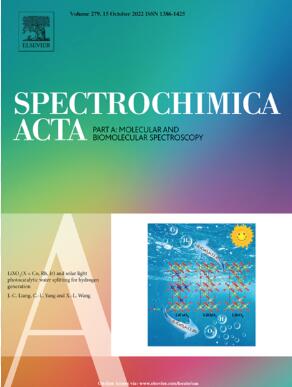Ratiometric fluorescent probe for triphosgene detection and its application in electrospun fluorescent fibers
IF 4.3
2区 化学
Q1 SPECTROSCOPY
Spectrochimica Acta Part A: Molecular and Biomolecular Spectroscopy
Pub Date : 2025-04-01
DOI:10.1016/j.saa.2025.126149
引用次数: 0
Abstract
Triphosgene poses a potentially great threat to human health and safety. Therefore, it is of great significance to develop an effective method to realize the inexpensive, on-site, convenient, and rapid detection of triphosgene. Herein, based on the excited-state intramolecular proton transfer mechanism, a new fluorescent probe DPIM was designed and synthesized, which realized the rapid ratiometric identification and detection of triphosgene for the first time. Its limit of detection for triphosgene was 3.54 × 10−8 M, and it had a large Stokes shift of 198 nm. Its recognition mechanism was comprehensively analyzed. A smartphone detection platform and probe-loaded test paper were prepared to realize the inexpensive, on-site, and convenient detection of triphosgene. DPIM effectively enabled the ratiometric fluorescence “turn-on” for detecting residual triphosgene in the sand, showing its application practicality. Most importantly, the probe was incorporated into nanofibers and successfully used to monitor gaseous triphosgene with high specificity, showing its excellent application potential. This study provides a promising analytical tool for the rapid quantitative detection of triphosgene in solution and gaseous phases.

求助全文
约1分钟内获得全文
求助全文
来源期刊
CiteScore
8.40
自引率
11.40%
发文量
1364
审稿时长
40 days
期刊介绍:
Spectrochimica Acta, Part A: Molecular and Biomolecular Spectroscopy (SAA) is an interdisciplinary journal which spans from basic to applied aspects of optical spectroscopy in chemistry, medicine, biology, and materials science.
The journal publishes original scientific papers that feature high-quality spectroscopic data and analysis. From the broad range of optical spectroscopies, the emphasis is on electronic, vibrational or rotational spectra of molecules, rather than on spectroscopy based on magnetic moments.
Criteria for publication in SAA are novelty, uniqueness, and outstanding quality. Routine applications of spectroscopic techniques and computational methods are not appropriate.
Topics of particular interest of Spectrochimica Acta Part A include, but are not limited to:
Spectroscopy and dynamics of bioanalytical, biomedical, environmental, and atmospheric sciences,
Novel experimental techniques or instrumentation for molecular spectroscopy,
Novel theoretical and computational methods,
Novel applications in photochemistry and photobiology,
Novel interpretational approaches as well as advances in data analysis based on electronic or vibrational spectroscopy.

 求助内容:
求助内容: 应助结果提醒方式:
应助结果提醒方式:


